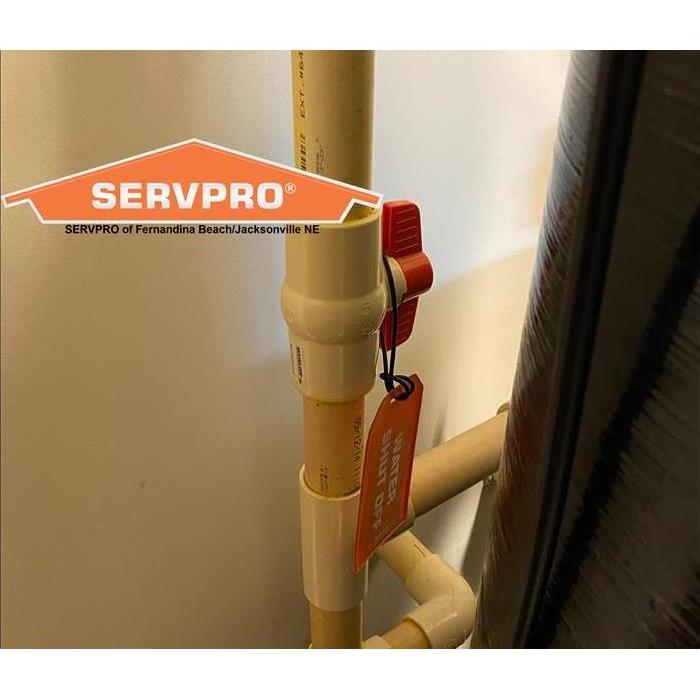Recent Water Damage Posts
5 Spring Cleaning Tips to Avoid Water Damage
3/15/2024 (Permalink)
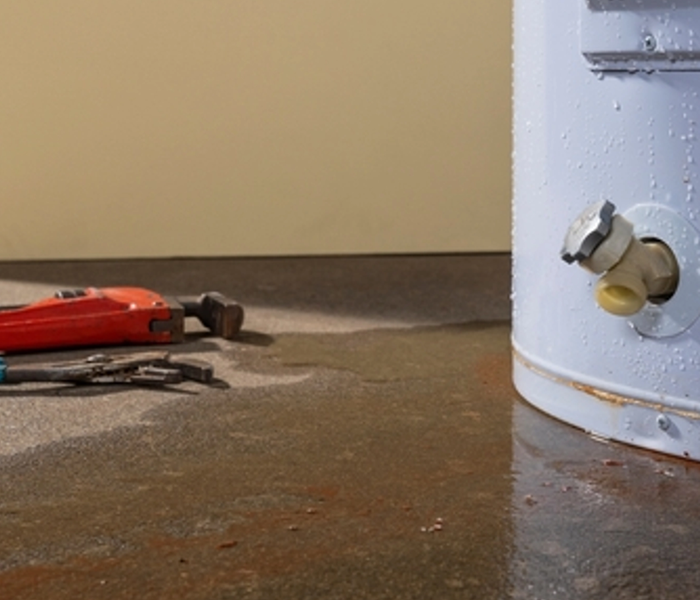 Maintain appliances to avoid water damage!
Maintain appliances to avoid water damage!
Tip #1: Inspect Appliances for Leaks
Leaking appliances are a leading cause of water damage in residential settings. Dishwashers, refrigerators, water heaters and washing machines are water damage disasters waiting to happen, so it is essential to regularly inspect these appliances to ensure that they are functioning correctly and have not been damaged.
- Look for signs of small leaks that may usually go unnoticed
- Replace defective, cracked, or torn seals
- Inspect all supply hoses
- Make sure all valve connections are tight
- Look into acquiring a leak detector
- Inspect the dishwasher door gaskets after cleaning
- Consider upgrading to stainless steel cord instead of plastic supply tubing for water supply tubes to the washing machine
Tip #2: Survey the Roof and Attic for Damage and Leaks
Roof leaks are another top cause of water leaks. A leaking roof allows water intrusion to damage the ceiling, attic, and walls, causing wooden building materials to rot and mold growth to occur.
If the home has an attic, look for any signs or smells of water damage or microbial growth.
If you notice anything that needs closer inspection or repair, call a roofer.
Tip #3: Remove Clogs and Blockages From Gutters and Downspouts
Gutters and downspouts help guide water away from the foundation of a house, preventing water from entering the structure or compromising the foundation. When these fixtures become clogged, the water build-up can rot away the wooden exterior near the eaves and create new avenues for water to migrate into the home.
Remove leaves, moss, debris, mildew, mold, or any other obstructions. Never use a pressure washer to clean gutters and downspouts since the high pressure and heat of this cleaning method can cause damage.
Tip #4: Apply Caulk to Any Cracks or Gaps in the Home’s Exterior and Interior
Gaps and cracks are an easy entry for water to intrude into a home. Inspect the house for cracks and thorough attention to the joints and frames of windows. Use the appropriate caulk to seal the area or, for cracks in masonry and concrete, use hydraulic cement.
Tip #5: Ensure the Landscaping Does Not Direct Water Towards the Home
Warmer temperatures make spring and summer a favorite time to plan and work on landscape projects. One landscape project that can prevent water damage involves adjusting the yard so that it directs water away from the home. While most properties have grading that slopes away from the house, some properties are not graded properly, which means that water can pool near the house and compromise the foundation. Solutions that are less intrusive than adjusting the grading include a French drain, an underground drainpipe, or a dry creek.
If you incur a water damage, from any source, SERVPRO of Jacksonville Northwest is available 24/7 for your water damage restoration needs!
Water Damage Timeline
2/21/2024 (Permalink)
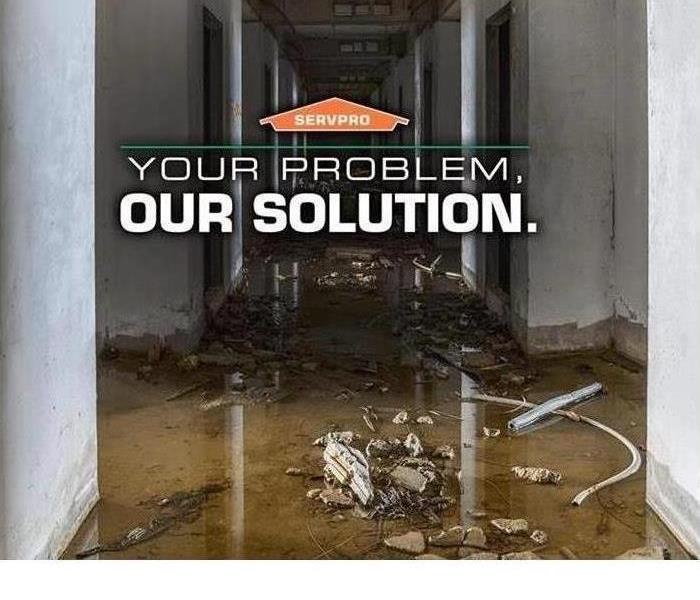 SERVPRO Water Damage
SERVPRO Water Damage
Whether Your Hot Water Leaks or a Storm With Torrential Rain, Water Invades Your Home or Structure the Same.
Within Minutes
- Water quickly spreads throughout your property, saturating everything in its path.
- Water is absorbed into walls, floors, upholstery, and belongings.
- Furniture finishes may bleed, causing permanent staining on carpets.
- Photographs, books, and other paper goods start to swell and warp. Be sure to move keepsakes and important papers to another area or a waterproof safe.
Hours 1 - 24:
- Drywall begins to swell and break down.
- Metal surfaces begin to tarnish.
- Furniture begins to swell and crack.
- Dyes and inks from cloth and paper goods spread and stain.
- A musty odor appears.
48 Hours to 1 Week:
- Mold and mildew may grow and spread.
- Doors, windows, and studs swell and warp.
- Metal begins to rust and corrode.
- Furniture warps and shows signs of mold.
- Paint begins to blister.
- Wood flooring swells and warps.
- Serious biohazard contamination is possible.
More Than 1 Week:
- Restoration time and cost increase dramatically; replacing contaminated materials and structural rebuilding may be extensive.
- Structural safety, mold growth, and biohazard contaminants pose serious risks to occupants.
As you can see, the longer it takes for disaster cleanup to begin, the likelihood of items being salvageable greatly and quickly increases. This is not a situation an individual family is able to handle on their own.
It is imperative to act quickly by calling SERVPRO of Jacksonville Northwest to get control of the water migration to protect your possessions and the structure!
Water? Do not fear, SERVPRO is here.
2/9/2024 (Permalink)
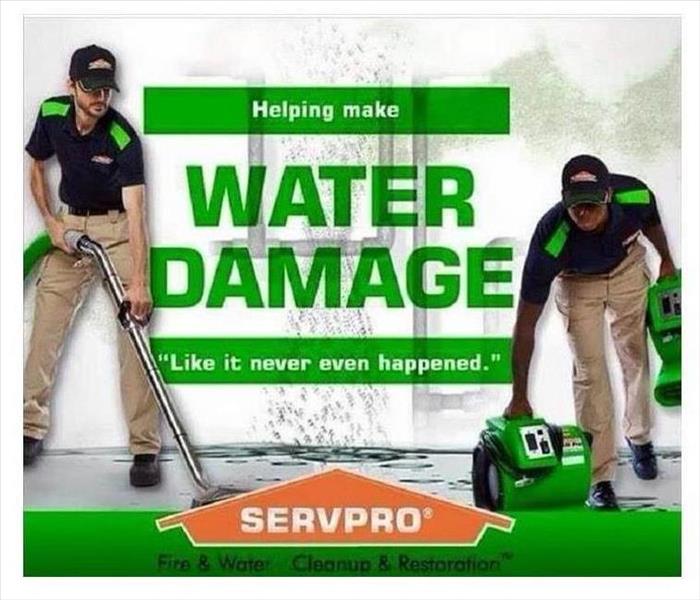 SERVPRO, water damage, water restoration, water cleanup, water remediation, water mitigation.
SERVPRO, water damage, water restoration, water cleanup, water remediation, water mitigation.
SERVPRO is known for its expertise in water damage restoration. Here are the general procedures SERVPRO typically follows when addressing water damage:
Emergency Contact: Upon receiving a call, SERVPRO responds quickly to assess the situation and determine the extent of the water damage.
Inspection and Assessment: Trained professionals inspect the property to identify the source of water and assess the damage. This includes determining the category and classification of the water damage, which helps in planning the restoration process.
Water Extraction: Using powerful pumps and vacuums, SERVPRO extracts standing water from the affected area promptly to prevent further damage and promote drying.
Drying and Dehumidification: After water extraction, SERVPRO employs specialized drying equipment such as air movers and dehumidifiers to remove moisture from surfaces, walls, carpets, and other materials.
Cleaning and Sanitizing: SERVPRO cleans and sanitizes affected areas, including walls, floors, furniture, and other belongings, to prevent mold and microbial growth and ensure a safe environment.
Restoration and Repairs: Depending on the extent of the damage, SERVPRO may perform necessary repairs and restoration work to restore the property to its pre-damaged condition. This could involve replacing damaged drywall, flooring, or other structural elements.
SERVPRO's water damage restoration procedures are designed to minimize disruption, mitigate further damage, and restore the property efficiently and effectively. Their trained technicians follow industry standards and best practices to ensure thorough and professional restoration services.
Avoid DIY Disaster
1/24/2024 (Permalink)
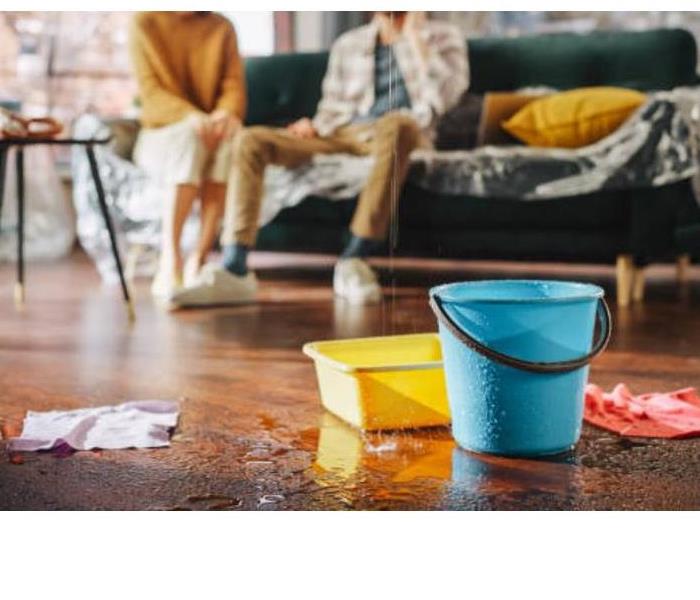 Avoid DIY Disaster
Avoid DIY Disaster
Water damage can strike at any time, often when you least expect it. Whether it's due to a burst pipe, flooding, or storm damage, knowing what to do in the immediate aftermath can make all the difference. At SERVPRO of Jacksonville Northwest, we want to empower you with essential water damage restoration tips to help protect your property and expedite the recovery process.
Safety First:
Before you jump into restoration, prioritize your safety:
- Ensure that the area is safe to enter, especially after a major flood or storm.
- Turn off the electricity to avoid electrical hazards.
- Wear appropriate safety gear, including gloves and protective clothing, when working with contaminated water.
Assess the Damage:
After safety is assured, take these steps:
Document the Damage: Take photos or videos of the affected areas. This documentation will be crucial for insurance claims.
Stop the Source: If possible, identify and stop the source of the water intrusion. Shut off the main water supply if needed.
Protect Valuables: Remove valuable items, documents, and electronics from the affected area.
Contacting a professional restoration company is crucial. SERVPRO's experts are trained to assess and mitigate water damage effectively. The sooner you reach out, the faster the restoration process can begin.
Begin Drying and Mitigation:
While waiting for SERVPRO's team to arrive, you can take some initial steps to mitigate further damage:
Remove Excess Water: Use mops or towels to remove standing water.
Ventilate the Area: Use fans and open windows to promote air circulation and aid in drying.
Dehumidify: If available, use a dehumidifier to remove excess moisture from the air.
Move Furniture: Elevate furniture on blocks or foil to prevent further damage.
Avoid DIY Restoration:
While it's tempting to handle water damage restoration on your own, it's best left to the professionals. Water damage can lead to mold growth, structural issues, and health hazards if not addressed correctly.
Insurance Claims:
Contact your insurance company as soon as possible and provide the documentation you collected earlier. SERVPRO of Jacksonville Northwest work directly with your insurance company to streamline the claims process.
Prevent Future Water Damage:
Once your property is restored, consider these preventative measures:
Regular Maintenance: Inspect your plumbing, roof, and foundation regularly to catch potential issues before they lead to water damage.
Proper Landscaping: Ensure your yard is properly graded to prevent water from flowing toward your foundation.
Sump Pump: Consider installing a sump pump in your basement or crawlspace to prevent flooding.
Water damage restoration is a daunting process, but with the right steps and the help of professionals like SERVPRO of Jacksonville Northwest, your property can be restored to its former glory. By following these tips and acting swiftly, you can minimize the impact of water damage and protect your investment. If you're faced with water damage, don't hesitate to reach out to us for a prompt and efficient restoration process. Your property's recovery is our priority.
How to Efficiently Clean Up Water Damage
11/9/2023 (Permalink)
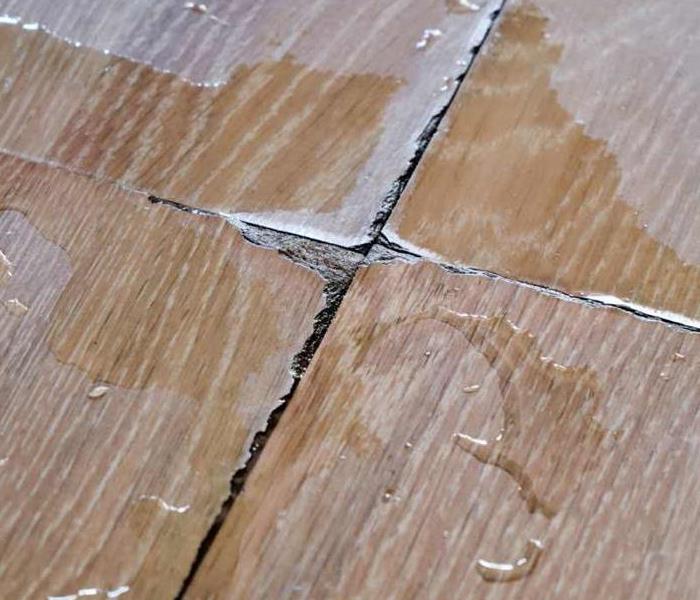 Active Water Damage in Home.
Active Water Damage in Home.
Water damage can be a frustrating and costly event for homeowners. Whether it is caused by a leaky pipe, a flood or a burst water heater, it is important to address the issue promptly to prevent further damage and growth. In this blog post, we will outline a step-by-step guide to efficiently clean up water damage and restore your home back to its original state.
1. Ensure Safety:
Before starting the cleaning process, it is crucial to ensure your safety. Turn off the power supply to the areas to avoid the risk of electrocution. Additionally, wearing protective gear such as gloves, boots, and masks is essential to protect yourself from contamination.
2. Remove Excess Water:
Using an extraction machine, tool or a water pump, to remove as much excess water as possible from the area. Start by extracting the water from the floor, carpets, and furniture. Make sure all water is extracted before going into any drying processes.
3. Drying Dehumidification:
Once the excess water is removed, the next step is to dry out thoroughly. Set up air movers and use dehumidifiers to promote air circulation and speed up the drying process. Make sure to dry not only the visible surfaces but also hidden areas such as behind walls and under flooring to prevent mold growth.
4. Salvage:
Evaluate the affected items and determine which can be salvaged and which need to be discarded. Porous materials such as carpets, upholstery, and drywall should be removed and replaced if they are heavily soaked or contaminated. Non-porous items can be cleaned and disinfected using a mixture of water and bleach or a commercial disinfectant.
5. Prevent Mold Growth:
After the water damage cleanup, it is crucial to prevent mold growth. Use mold-inhibiting spray apply antimicrobial treatments to the affected surfaces. Monitor the humidity levels in your home and a hygrometer to ensure they remain below 50%. Consider installing a dehumidifier or using moisture absorbers to maintain a dry environment.
6. Professional Restoration:
In severe cases of damage, such as extensive flooding or damage to the structure of the house, it is advisable to seek SERVPRO of Jacksonville Northwest. Experienced professionals such as us have the expertise and equipment to handle complex situations and ensure thorough restoration of your home.
Conclusion:
Water damage can be a challenging situation to deal with, but following the steps outlined above, you can efficiently clean up the damage and restore your home to pre loss condition. Remember to prioritize safety, remove excess water, thoroughly dry the affected areas, salvage and disinfect items, and take preventive measures to avoid mold growth. If in doubt, do not hesitate to contact SERVPRO of Jacksonville Northwest's professional restoration services to ensure a successful cleanup process.
Fallen Ceiling in Jacksonville Northwest
7/20/2023 (Permalink)
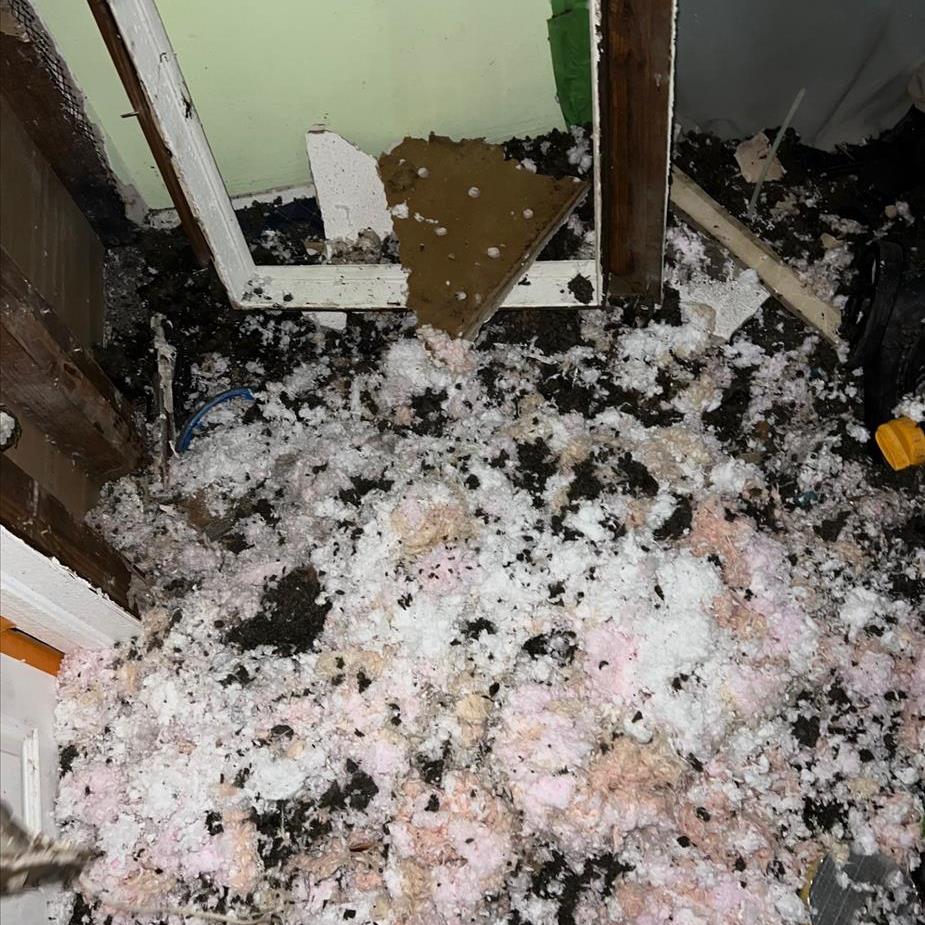 Fallen plaster ceiling and blown in insulation after AC Leak water damage.
Fallen plaster ceiling and blown in insulation after AC Leak water damage.
A local unsuspecting home in Jacksonville Northwest experienced a traumatic experience in their ceiling falling after they've returned home. In secret, their AC unit has been leaking for a great amount of time and eventually the plaster ceiling fell through due to the water intrusion and erosion of material. When is the last time you've checked your AC Unit warranty or Emergency water pan? AC Unit's malfunctioning and leaking are very common in water damages. Check your AC Units to ensure they're properly functioning and don't harm your homes. SERVPRO of Jacksonville Northwest specializes in AC Leaks and the water damage related to such leaks that may come from it. Call SERVPRO of Jacksonville Northwest for any types of consultations about water damage or our services.
Locating Water Shut Off Valves in an Emergency
2/1/2023 (Permalink)
No one expects pipes to burst, water heaters to break, or toilets and washers to overflow. If this happens, your quick response along with the highly trained specialists of SERVPRO of Fernandina Beach/Jacksonville Northeast will limit your damages and potentially save you thousands of dollars! Here are some tips for locating water shut-off valves on your property.
How to Find the Water Shut-Off Valves
If you have a water emergency, knowing the location of the shut-off valve could save you thousands in water damage repairs. Home water systems contain two types of shut-off valves: main or master shut- off valves for stopping the flow of water to the entire house. These can be tricky and might involve the help of a professional—like a plumber or SERVPRO. An alternative is finding individual or supply shut-off valves for specific appliances and fixtures. Try these first.
Try to Cut Off Water Close to Source
If you have a leak at your toilet, sink, clothes washer, or ice maker, shut off water close to the source:
- Toilet: Look under the toilet, against the wall for the flexible metal tubing. Turn the handle clockwise until it stops. Do not force.
- Sink: Look under the sink cabinet. There will be two sets of flexible metal or plastic tubing. Turn handles clockwise.
- Clothes Washer: Some houses have the valves clearly exposed above and behind the washer. Turn both valves clockwise. If you do not see these valves, slide the washer outward and you will likely see them.
- Dishwashers: The water supply tube running to the dishwasher often has a fixture shut-off valve controlling it. In many cases, this is also located under the kitchen sink base cabinet, and it may be close proximity to the sink faucet shut-off valves.
- Refrigerator ice makers/water dispensers: The small copper or mesh supply tube running to the refrigerator usually has a small saddle valve or other devices that can be shut off to close down the water supply.
Locate Water Main Shut-Off Valve Within the House
This is the best way to shut off water in your house, but locating water shut-off valves indoors can prove to be a tricky task. It will, however, cut off your home's entire water supply, allowing you to open up any pipe within the house.
Hopefully your water shut-off falls can be easily found--either the knob or lever on a border wall. However, if it’s not so easy to locate, your valve is likely in one of these following places:
- On a perimeter wall of your house
- At ground level, so you’ll be looking for it lower on the wall if you’re on the ground level floor
- In a straight line from your outdoor water meter
- Noted on your property inspection report from when you purchased the house
- Behind an access panel
- NOT under a sink or next to the water heater
If you don’t want to play plumbing detective, or if you need help locating your main water shut-off valves, you can schedule a service call for SERVPRO of Fernandina Beach/Jacksonville Northeast.
Did You Know: A Water Damaged Wall Can Be Dried & Restored, Rather Than Replaced?
5/10/2022 (Permalink)
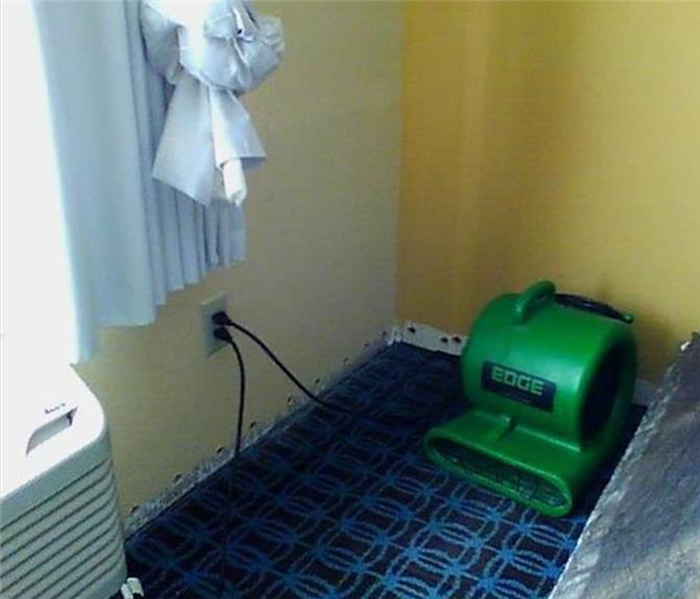 Drilling small holes along the bottom of the wall and ventilating the wall cavity can greatly reduce drying time.
Drilling small holes along the bottom of the wall and ventilating the wall cavity can greatly reduce drying time.
So a plumbing leak or other water intrusion leaves you with wet walls. Here’s the question we at SERVPRO often get: Do the walls have to be removed and replaced? Well, it depends.
In the past, restoration practices called for the replacement of wet drywall from walls. Today there is technology that allows SERVPRO to save walls by drying them, which significantly reduces restoration costs.
It’s part of SERVPRO’s restore vs. replace philosophy, and it can save homeowners (or businesses) a bundle.
Factors to Consider & Steps Involved
When floodwaters or sewage have entered the home—or when structural integrity has been compromised--industry standards require the removal of porous building materials. In most other cases, saving a wall is possible when a skilled restorer such as SERVPRO of Jacksonville Northwest uses the appropriate techniques.
A common impediment to effectively drying walls is a vapor barrier, which is a material that impedes the evaporation of moisture from walls or other materials. Removing the outer vapor barrier or perforating gloss paint expedites the drying process.
Another consideration is insulation. A wall may contain fiberglass, spray foam, or blown-in insulation. Blown-in fiberglass can compact and move down the wall cavity when it becomes wet. When this happens, the insulating properties of the materials cannot be restored. The insulation will need to be removed and replaced. Fiberglass insulation with paper backing can usually be successfully dried using air injection or similar methods. Sprayed-in insulation usually needs to be removed.
Drying can be accelerated by drilling small holes along the bottom of the wall and ventilating the wall cavity, greatly reducing drying time. When drying is complete, these holes are patched or, ideally, covered by baseboard. The process described above is faster and less expensive than removing and replacing walls.
SERVPRO’s IICRC-certified technicians employ a specific set of standards that incorporate the field of psychometry, which involves the manipulation of temperature and relative humidity, and special equipment to measure and remove moisture and to dry a property quickly and effectively.
It's the Water that You Can't See
2/2/2022 (Permalink)
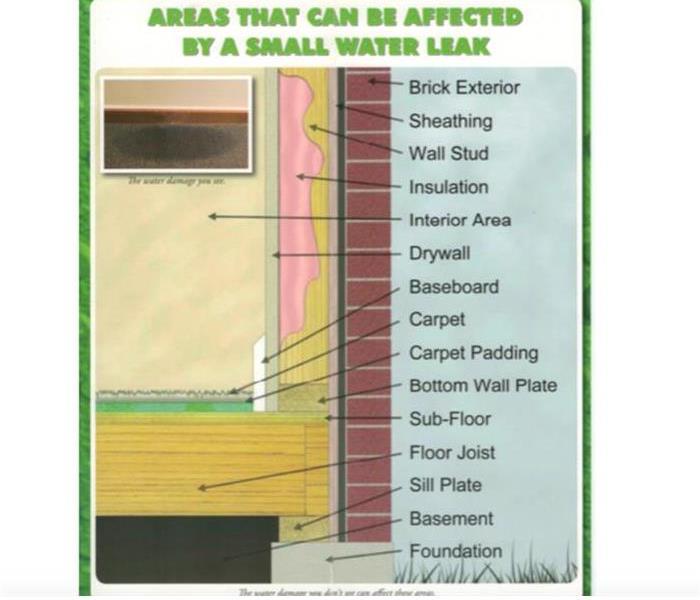 When you have a leak, many areas of your home that you can't see can be affected.
When you have a leak, many areas of your home that you can't see can be affected.
When your home or business experiences a major flood, there’s no chance you won’t see it.
A few inches of water in your basement, an overflowing toilet or a broken sprinkler are tough to overlook and so is the damage they cause.
However, there is a culprit that might not make a big splash, but can cause serious structural and indoor air quality issues: the water you don’t see.
Sometimes you might have hidden leaks or humidity issues that can start small and grow large in their destruction over time. The little leaks might turn into large deluges or wear away at structures, the humidity could make conditions right for mold growth and bad odors.
As a home or business owner, you want to be on the lookout for these sneaky sources of water loss. You also want to make sure that, if you do experience a large flood, to get it cleaned up properly. Improper water cleanup can leave those hidden problems behind.
As the diagram shows, when you have a leak, many areas can be affected. Water can make its way into sheathing, studs, insulation, drywall, baseboards, carpet and padding, wall plate, sub-floor, sill plate, and your basement and foundation.
This is where SERVPRO of Jacksonville Northwest comes in. We have the knowledge and experience clean up water damage of any size and get it done right the first time. We also have the proper equipment to find any moisture lurking out of sight and do away with it.
For example, we have moisture sensors, which are used to detect moisture in carpets, baseboards and walls. We have moisture meters that we use to test the actual moisture content of materials. The meters allow our technicians to accurately monitor the drying process.
And if hidden water leads to bad odors in your business, we have the tools necessary to take care of those as well. Some examples are ultra low-volume foggers and thermal foggers.
The lesson here is to be aware that water losses can be hiding in your home or business and if you find them, you can count on us to fix them.
Call SERVPRO of Jacksonville Northwest at 904.256.4894.
Flooding Strikes Three Units in Jacksonville Condo
1/26/2022 (Permalink)
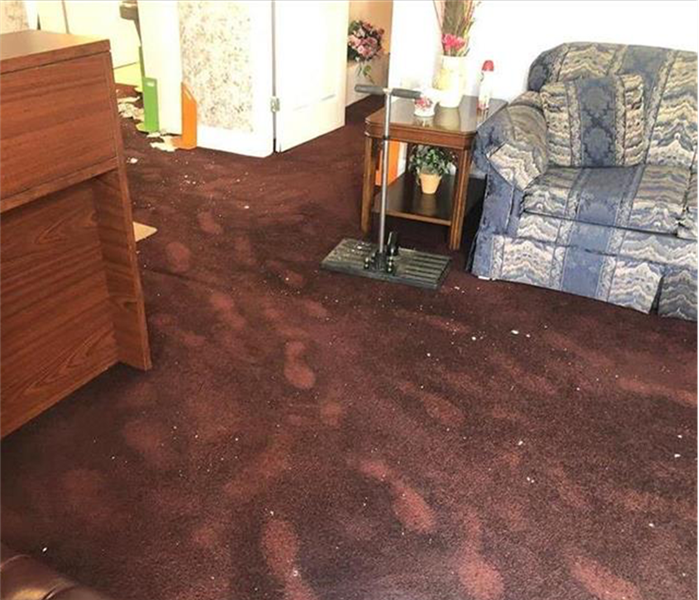 If you have water damage or flooding, call us at 904.256.4894.
If you have water damage or flooding, call us at 904.256.4894.
Flooding from a toilet supply line damaged three units in a Jacksonville condo. Fortunately, SERVPRO of Jacksonville Northwest arrived on the scene quickly to extract water and began the drying process in order to minimize damages.
The first 24 hours following a water loss are the most important in preventing secondary or permanent damage. Here are some steps you can take while waiting for the professionals of SERVPRO of Jacksonville Northwest to arrive.
Emergency Water Damage Tips
- Shut-off the water source, if possible or contact a professional such as SERVPRO, a plumber, or maintenance personnel to stop the water source.
- Turn-off circuit breakers for wet areas of the building when access to the power distribution panel is safe from electrical shock.
- Remove as much excess water as possible by mopping and blotting.
- Place aluminum foil or wood blocks between furniture legs and wet carpeting.
- Move any paintings, art objects, computers, documents, and other sensitive valuables to a dry place.
- Do not use your household vacuum cleaner to remove water! This could cause electrical shock or damage to the device.
For more information on recovering from water damage, contact SERVPRO of Jacksonville Northwest at 904.256.4894.
Three Types of Contaminated Water and Restoration Steps
10/6/2021 (Permalink)
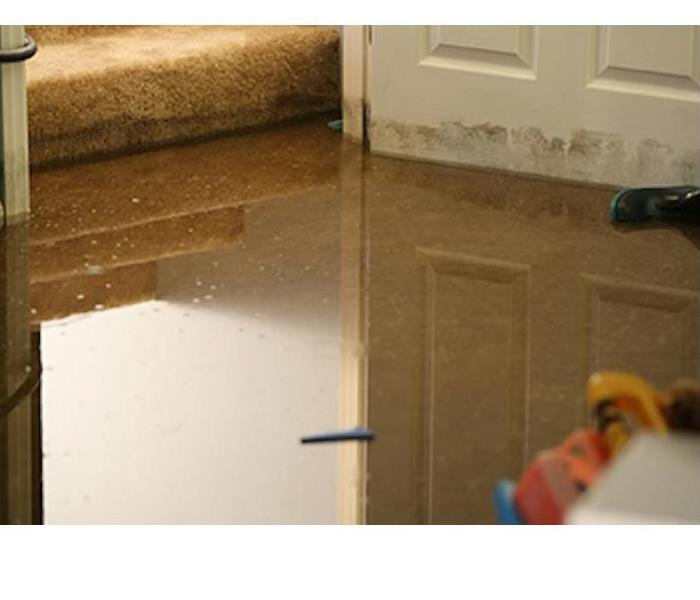 The category of water damage impacts what types of mitigation and restoration steps are needed.
The category of water damage impacts what types of mitigation and restoration steps are needed.
When evaluating the types of water damage and how they affect an emergency water removal situation on a property, it helps to know that water losses fall into three categories:
Category 1: Clean Water
Category 1 water is from a clean source like a broken water supply line or leaking faucet. If not treated quickly, this water can turn into category 2 or 3, depending on length of time, temperature, and contact with surrounding contaminants.
Category 2: Gray Water
Category 2 water is contaminated and could cause discomfort or illness. Examples include washing machine overflow; toilet overflow with some urine, but no feces; or dishwasher overflow.
- May contain bacteria and viruses
- Can quickly degrade into category 3 if left untreated
Category 3: Black Water
Category 3 water is grossly contaminated and could cause severe illness or death if ingested and any contact should be avoided. Examples include flooding from rivers or streams, water from beyond the toilet trap, water from the toilet bowl with feces, or standing water that has begun to support microbial growth.
- May contain untreated sewage, harsh chemicals, and microbes
- Water from flooding rivers or sewer backup
Sewage cleanup must not be taken lightly. Serious long term health issues to adults, children and pets may occur due to bacteria, viruses and even parasites.
Restoration Procedures
Evaluation
Water damage restoration is often prefaced by a loss assessment and evaluation of affected materials into the categories described above. The damaged area is inspected with water sensing equipment such as moisture meters and other infrared tools in order to determine the source of the damage and the possible extent of areas affected.
Mitigation, Restoration & Drying
Emergency mitigation services are the first order of business. Controlling the source of water, removal of non-salvageable materials, water extraction and pre-cleaning of impacted materials are all part of the mitigation process. Restoration services would then be rendered to the property in order to dry the structure, stabilize building materials, sanitize any affected or cross-contaminated areas, and deodorize all affected areas and materials. After the labor is completed, water damage equipment including air movers, air scrubbers, dehumidifiers, wood floor drying systems, and sub-floor drying equipment is left in the residence. The goal of the drying process is to stabilize the moisture content of impacted materials below 15%. We at SERVPRO return at regular time intervals, preferably every twenty-four hours, to monitor the equipment, temperature, humidity, and moisture content of the affected walls and contents.
Reconstruction Services
Once dried we can commence to perform any reconstruction or remodeling services desired by the property owner. These services may be limited to replacing drywall, baseboards, and trim boards, or may entail a complete renovation if desired--including floors, cabinetry, appliances, countertops, painting, and a host of related services,
If you have water damage, don't delay. Take immediate action. Call SERVPRO of Jacksonville Northwest at 904.256.4894.
How to Shut Off Your Water in Case of Emergency
9/10/2021 (Permalink)
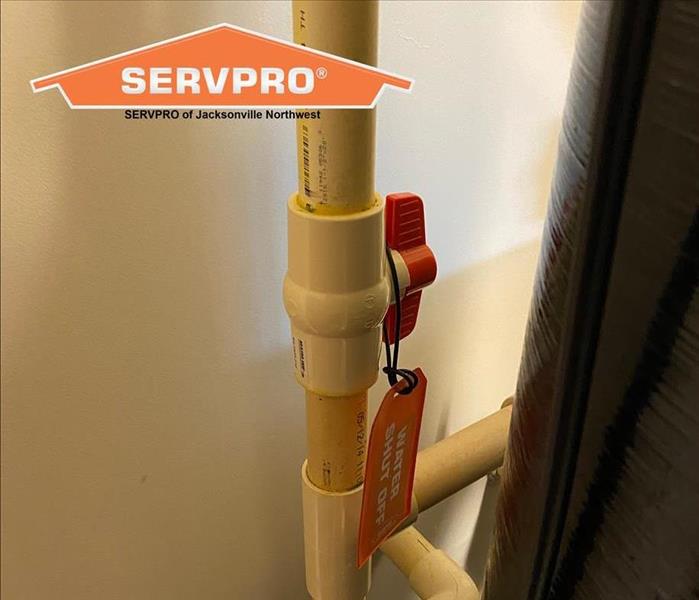 At this home, the water shut-off valve is located inside the garage.
At this home, the water shut-off valve is located inside the garage.
No one expects pipes to burst, water heaters to break, or toilets and washers to overflow. If this happens, your quick response along with the highly trained specialists of SERVPRO of Jacksonville Northwest will limit your damages and potentially save you thousands of dollars! Here are some tips for locating water shut-off valves on your property.
Source: The Spruce…
How to Find the Water Shut-Off Valves
If you have a water emergency, knowing the location of the shut-off valve could save you thousands in water damage repairs. Home water systems contain two types of shut-off valves: main or master shut- off valves for stopping the flow of water to the entire house. These can be tricky and might involve the help of a professional—like a plumber or SERVPRO. An alternative is finding individual or supply shut-off valves for specific appliances and fixtures. Try these first.
Try to Cut Off Water Close to Source
If you have a leak at your toilet, sink, clothes washer, or ice maker, shut off water close to the source:
- Toilet: Look under the toilet, against the wall for the flexible metal tubing. Turn the handle clockwise until it stops. Do not force.
- Sink: Look under the sink cabinet. There will be two sets of flexible metal or plastic tubing. Turn handles clockwise.
- Clothes Washer: Some houses have the valves clearly exposed above and behind the washer. Turn both valves clockwise. If you do not see these valves, slide the washer outward and you will likely see them.
- Dishwashers: The water supply tube running to the dishwasher often has a fixture shut-off valve controlling it. In many cases, this is also located under the kitchen sink base cabinet, and it may be close proximity to the sink faucet shut-off valves.
- Refrigerator ice makers/water dispensers: The small copper or mesh supply tube running to the refrigerator usually has a small saddle valve or other devices that can be shut off to close down the water supply.
Locate Water Main Shut-Off Valve Within the House
This is the best way to shut off water in your house, but locating water shut-off valves indoors can prove to be a tricky task. It will, however, cut off your home's entire water supply, allowing you to open up any pipe within the house.
Hopefully your water shut-off falls can be easily found--either the knob or lever on a border wall. However, if it’s not so easy to locate, Lee Wallender of The Spruce suggests that your valve is likely in one of these following places:
- On a perimeter wall of your house
- At ground level, so you’ll be looking for it lower on the wall if you’re on the ground level floor
- In a straight line from your outdoor water meter
- Noted on your property inspection report from when you purchased the house (most likely in section 6.1)
- Behind an access panel
- NOT under a sink or next to the water heater
If you don’t want to play plumbing detective, or if you need help locating your main water shut-off valves, you can schedule a service call for SERVPRO of Jacksonville Northwest to come out and assist you. Call us at 904-256-4894 if you are interested. It would be money well spent to protect your home investment.


 24/7 Emergency Service
24/7 Emergency Service






